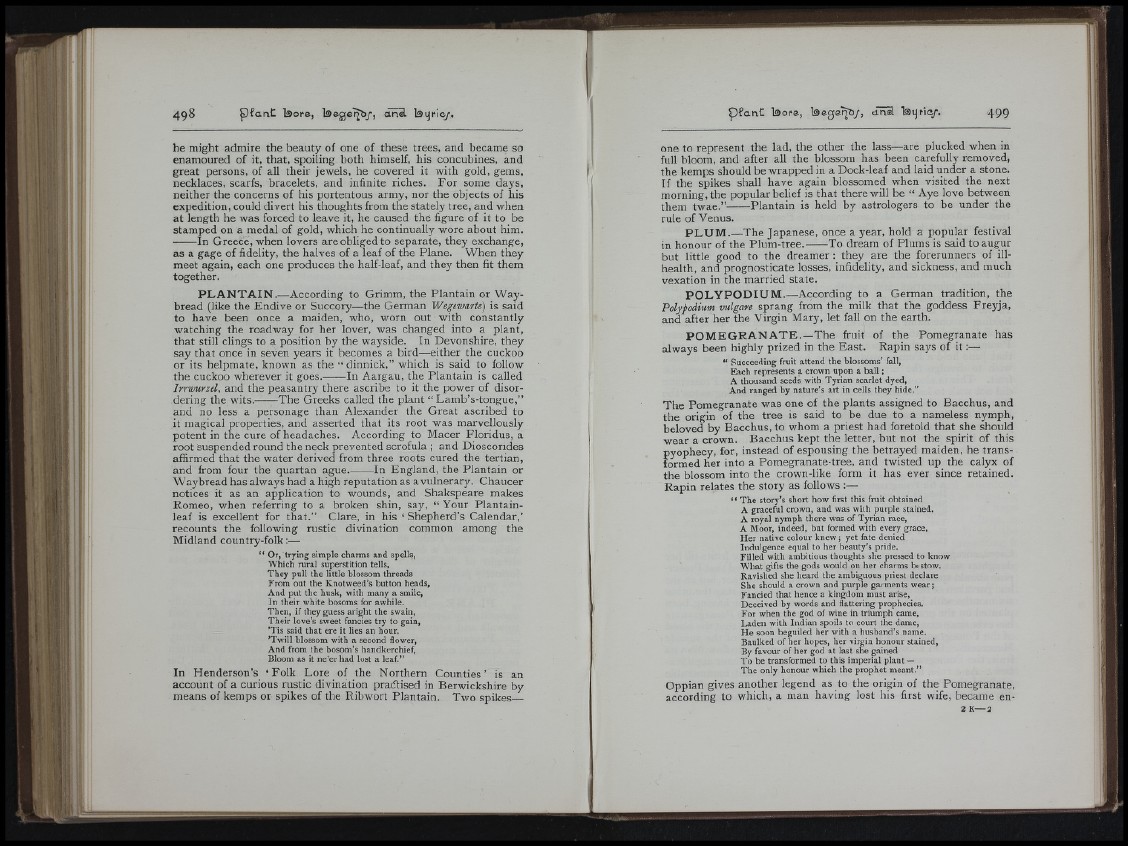
499
he might admire the beauty of one of these trees, and became so
enamoured of it, that, spoiling both himself, his concubines, and
great persons, of all their jewels, he covered it with gold, gems,
necklaces, scarfs, bracelets, and infinite riches. For some days,
neither the concerns of his portentous army, nor the objects of his
expedition, could divert his thoughts from the stately tree, and when
at length he was forced to leave it, he caused the figure of it to be
stamped on a medal of gold, which he continually wore about him.
In Greece, when lovers are obliged to separate, they exchange,
as a gage of fidelity, the halves of a leaf of the Plane. When they
meet again, each one produces the half-leaf, and they then fit them
together.
P L A N T A IN .—According to Grimm, the Plantain or Way-
bread (like the Endive or Succory—the German Wegewarte) is said
to have been once a maiden, who, worn out with constantly
watching the roadway for her lover, was changed into a plant,
that still clings to a position by the wayside. In Devonshire, they
say that once in seven years it becomes a bird—either the cuckoo
or its helpmate, known as the “ dinnick,” which is said to follow
the cuckoo wherever it goes. In Aargau, the Plantain is called
Irrwurzel, and the peasantry there ascribe to it the power of disordering
the wits. The Greeks called the plant “ Lamb’s-tongue,”
and no less a personage than Alexander the Great ascribed to
it magical properties, and asserted that its root was marvellously
potent in the cure of headaches. According to Macer Floridus, a
root suspended round the neck prevented scrofula ; and Dioscorides
affirmed that the water derived from three roots cured the tertian,
and from four the quartan ague. In England, the Plantain or
Waybread has always had a high reputation as a vulnerary. Chaucer
notices it as an application to wounds, and Shakspeare makes
Romeo, when referring to a broken shin, say, “ Your Plantain-
leaf is excellent for that.” Clare, in his ‘ Shepherd’s Calendar,’
recounts the following rustic divination common among the
Midland country-folk:—
t ( Or, trying simple charms and spells,
Which rural superstition tells,
They pull the little blossom threads
From out the Knotweed’s button heads,
And put the husk, with many a smile,
In their white bosoms for awhile.
Then, if they guess aright the swain,
Their love’s sweet fancies try to gain,
'T is said that ere it lies an hour,
'Twill blossom with a second flower,
And from the bosom’s handkerchief,
Bloom as it ne’er had lost a leaf.”
In Henderson’s ‘ Folk Lore of the Northern Counties ’ is an
account of a curious rustic divination pracftised in Berwickshire by
means of kemps or spikes of the Ribwort Plantain. Two spikes__
one to represent the lad, the other the lass—are plucked when in
full bloom, and after all the blossom has been carefully removed,
the kemps should be wrapped in a Dock-leaf and laid under a stone.
If the spikes shall have again blossomed when visited the next
morning, the popular belief is that there will be “ Aye love between
them twae.” Plantain is held by astrologers to be under the
rule of Venus.
P L U M .—The Japanese, once a year, hold a popular festival
in honour of the Plum-tree, To dream of Plums is said to augur
but little good to the dreamer : they are the forerunners of ill-
health, and prognosticate losses, infidelity, and sickness, and much
vexation in the married state.
P O L Y P O D IU M .—According to a German tradition, the
Polypodium vulgare sprang from the milk that the goddess Freyja,
and after her the Virgin Mary, let fall on the earth.
P O M E G R A N A T E .—The fruit of the Pomegranate has
always been highly prized in the East. Rapin says of i t :—
“ Succeeding fruit attend the blossoms’ fall,
Each represents a crown upon a b a ll;
A thousand seeds with Tyrian scarlet dyed,
And ranged by nature’s art in cells they hide.”
The Pomegranate was one of the plants assigned to Bacchus, and
the origin of the tree is said to be due to a nameless nymph,
beloved by Bacchus, to whom a priest had foretold that she should
wear a crown. Bacchus kept the letter, but not the spirit of this
pyophecy, for, instead of espousing the betrayed maiden, he transformed
her into a Pomegranate-tree, and twisted up the calyx of
the blossom into the crown-like form it has ever since retained.
Rapin relates the story as follows
“ The story’s short how first this fruit obtained
A graceful crown, and was with purple stained.
A royal nymph there was of Tyrian race,
A Moor, indeed, but formed with every grace,
Her native colour knew; yet fate denied
Indulgence equal to her beauty’s pride.
Filled with ambitious thoughts she pressed to know
What gifts the gods would on her charms bestow.
Ravished she heard the ambiguous priest declare
She should a crown and purple garments wear;
Fancied that hence a kingdom must arise,
Deceived by words and flattering prophecies.
For when the god of wine in triumph came,
Laden with Indian spoils to court the dame,
He soon beguiled her with a husband’s name.
Baulked of her hopes, her virgin honour stained,
By favour of her god at last she gained
To be transformed to this imperial plant —
The only honour which the prophet meant.”
Oppian gives another legend as to the origin of the Pomegranate,
according to which, a man having lost his first wife, became en-
2 K—2
i ,ll
4p
j
4